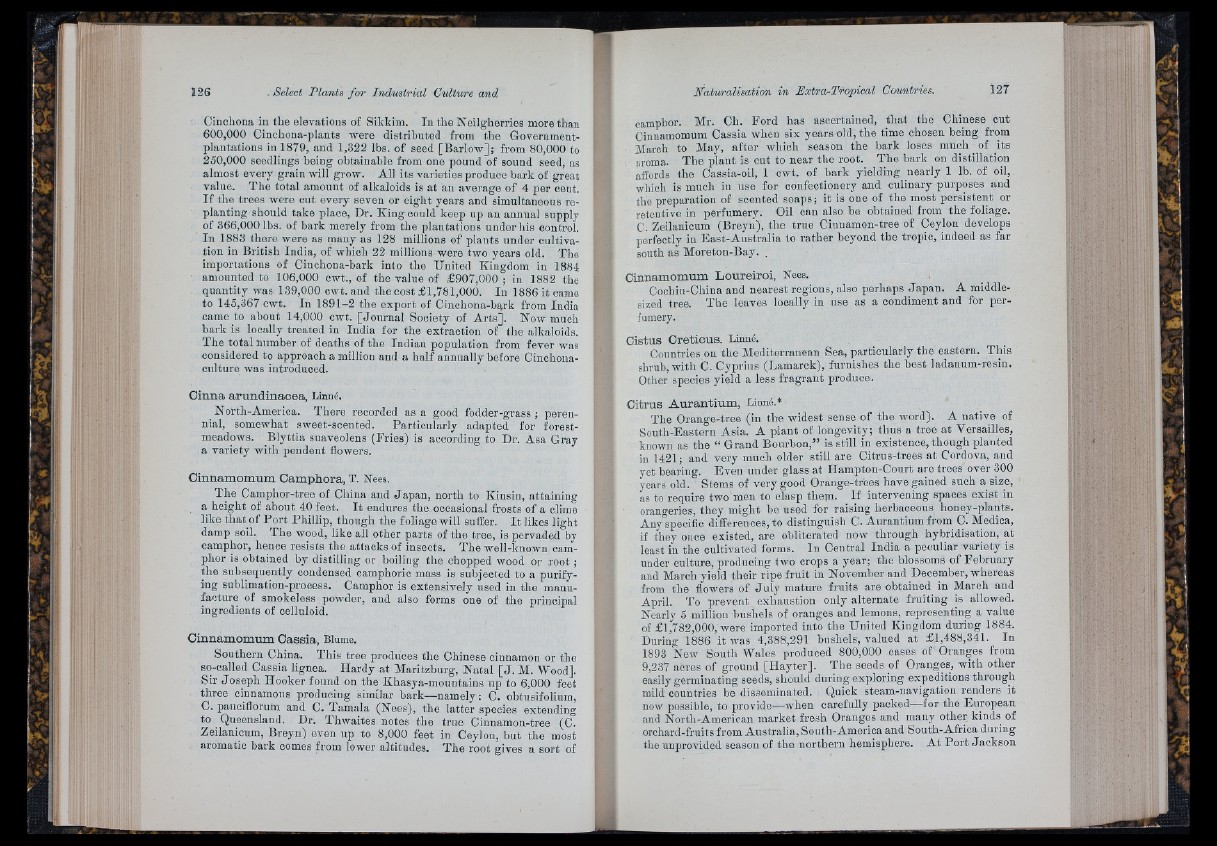
Cinchona in the elevations of Sikkim. In the Neilghemes more than
600.000 Cinchona-plants were distributed from the Government-
plantations in 1879, and 1,322 lbs. of seed [Barlow]; from 80,000 to
250.000 seedlings being obtainable from one pound of sound seed, as
almost every grain will grow. All its varieties produce bark of great
value. The total amount of alkaloids is at an average of 4 per cent.
I f the trees were cut every seven or eight years and simultaneous replanting
should take place, Dr. King could keep up an annual supply
of 366,000 lbs. of bark merely from the plantations under liis control.
In 1883 there were as many as 128 millions of plants under cultivation
in British India, of which 22 millions were two years old. The
importations of Cinchona-bark into the United Kingdom in 1884
amounted to 106,000 cwt., of the value of £907,000 ; in 1882 the
quantity was 139,000 cwt. and the cost £1,781,000. In 1886 it came
to 145,367 cwt. In 1891-2 the export of Cinchona-bark from India
came to about 14,000 cwt. [Journal Society of Arts]. Now much
bark is locally treated in India for the extraction of the alkaloids.
The total number of deaths of the Indian population from fever was
considered to approach a million aud a half annually before Cinchona-
culture was introduced.
C in n a a r u n d in a c e a , Linné.
North-America. There recorded as a good fodder-grass ; perennial,
somewhat sweet-scented. Particularly adapted for forest-
meadows. Biyttia suaveolens (Fries) is according to Dr. Asa Gray
a variety with pendent flowers.
C in n am o m u m C am p h o r a , T. Nees.
Ih e Camphor-tree of China and Japan, north to Kinsin, attaining
a height of about 40 feet. I t endures the occasional frosts of a clime
like that of P o rt Phillip, though the foliage w ill suffer. I t likes light
damp soil. The wood, like all other parts of the tree, is pervaded by
camphor, hence resists the attacks of insects. The well-known camphor
is obtained by distilling or boiling the chopped wood or root ;
the subsequently condensed camphoric mass is subjected to a purifying
sublimation-process. Camphor is extensively used in the manufacture
of smokeless powder, aud also forms one of the principal
ingredients of celluloid.
C in n am o m u m C a s s ia , Blume.
Southern China. This tree produces the Chinese cinnamon or the
so-called Cassia lignea. Hardy at Maritzburg, Natal [ J . M. Wood].
Sir Joseph Hooker found on the Khasya-mountains up to 6,000 feet
three cinnamons producing similar bark—namely : C. obtusifolium,
C. pauciflorum and C. Tamala (Nees), the latter species extending
to ^ Queensland. Dr. Thwaites notes the true Cinnamon-tree (C.
Zeilanicum, Breyn) even up to 8,000 feet iu Ceylon, but the most
aromatic bark comes from lower altitudes. The root gives a sort of
camphor. Mr. Ch. Ford has ascertained, th a t the Chinese cut
Cinnamomum Cassia when six years old, the time chosen being from
March to May, after which season the bark loses much of its
aroma. The plant is cut to near the root. The bark on distillation
affords the Cassia-oil, 1 cwt. of bark yielding nearly 1 lb. of oil,
which is muoli in use for confectionery and culinary purposes and
the preparation of scented soaps; it is one of the most persistent or
retentive in perfumery. Oil can also he obtained from the foliage.
C. Zeilanicum (Breyn), the true Cinnamon-tree of Ceylon develops
perfectly in East-Australia to rather beyond the tropic, indeed as far
south as Moreton-Bay. .
C in n am om um L o u r e ir o i, Nees.
Cochin-China and nearest regions, also perhaps Japan. A middle-
sized tree. The leaves locally in use as a condiment and for perfumery.
C is tu s C r e tio u s . Linné.
Countries on the Mediterranean Sea, particularly the eastern. This
shrub, w ith C. Cyprins (Lamarck), furnishes the best ladauum-resin.
Other species yield a less fragrant produce.
C itru s A u r a n t iu m , Linné.*
The Orange-tree (in the widest sense of the word). A native of
South-Eastern Asia. A plant of longevity; thus a tree at Versailles,
known as the “ Grand Bourbon,” is still in existence, though planted
in 1421; and very much older still are Citrus-trees at Cordova, and
yet bearing. Even under glass at Hampton-Conrt are trees over 300
years old. Stems of very good Orange-trees liave gained such a size,
as to require two men to clasp them. If intervening spaces exist in
orangeries, they might be used for raising herbaceous honey-plants.
Any specific differences, to distinguish C. Aurantium from C. Mediea,
if they once existed, are obliterated now through hybridisation, at
least in the cultivated forms. In Central India a peculiar variety is
under culture, producing two crops a year; the blossoms of February
and March yield their ripe fruit in November and December, whereas
from the flowers of Ju ly mature fruits are obtained in March and
April. To prevent exhaustion only alternate fruiting is allowed.
Nearly 5 million bushels of oranges and lemons, representing a value
of £1,782,000, were imported into the United Kingdom during 1884.
During 1886 it was 4,388,291 bushels, valued at £1,488,341. In
1893 New South Wales produced 800,000 cases of Oranges from
9,237 acres of ground [Hayter]. The seeds of Oranges, with other
easily germinating seeds, should during exploring expeditions through
mild countries be disseminated. Quick steam-navigation renders it
now possible, to provide—when carefully packed—for the European
and North-American market fresh Oranges and many other kinds of
orohard-fruits from A ustralia, South-America and South-Africa during
the unprovided season of the northern hemisphere. A t Po rt Jackson